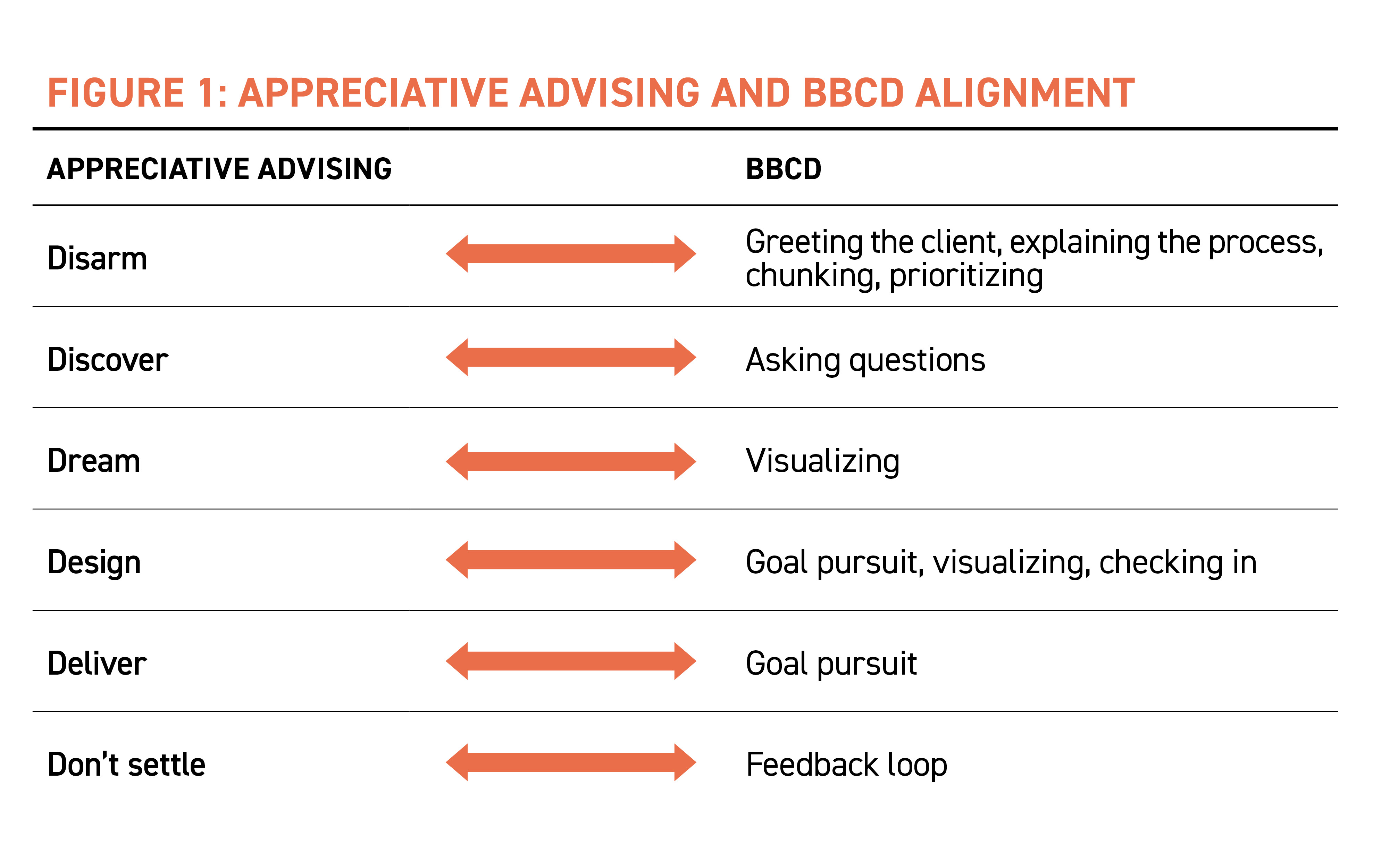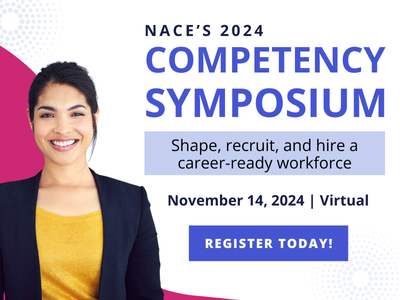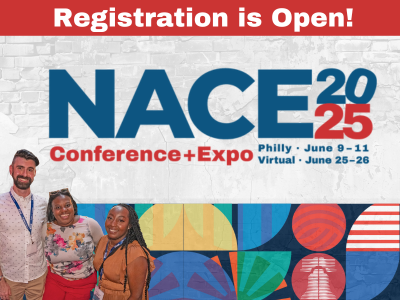How intentionally blending appreciative advising and brain-based career development can help us all better serve our students
NACE Journal, February 2021
The relationship between academic advising and career development has always been inextricable. For example, in the early 1970s, Terry O’Banion argued that an academic adviser must first get to know a student and explore their life and vocational goals before discussing the student’s program of study, courses, and schedules.1 Just as academic advising is about far more than scheduling classes for students, career coaching encompasses more than just selecting a career. If academic advisers and career coaches are truly focused on meeting the holistic needs of students, their conversations with students will likely encompass elements of both academic and career development.
Given the overlap between academic advising and career development, the lack of sharing of best practices between the professions is surprising. One possible reason for the disconnect may be the lack of a shared language, mindset, and theoretical framework. However, the advantages of academic advising and career coaching professionals engaging in conversations on how to improve respective practices are numerous. Frankly, the complexity of the challenges facing higher education demands that career services professionals, academic advisers, and faculty work together to create innovative solutions to those challenges. Furthermore, these partnerships should be mutually beneficial and woven into the infrastructure of higher education systems. Imagine if academic advisers and career coaches used the same theory-to-practice framework and shared terminology when discussing majors, careers, co-curricular involvement, and coursework. Not only would it help to better learn from each other and to make more effective student referrals to each other’s offices, but it would also contribute to students’ sense of belonging, streamline students’ experiences across the institution, and create a healthier work environment for students, faculty, administrators, and staff alike.
Although some institutions have begun to merge academic advising and career services, we argue that these two professions need to partner together more intentionally to provide a seamless and coherent experience for students. The purpose of this article is to bridge the work academic advisers and career coaches do by mapping the synergies between a mainstream academic advising theory-to-practice framework (appreciative advising—AA) and a career coaching model (brain-based career development—BBCD). We will showcase how BBCD principles can be aligned within the six phases of appreciative advising to enhance the effectiveness of both career coaching and academic advising interactions with students. Notably, both AA and BBCD are frameworks that also invite the academic advisers and career coaches to infuse other theoretical approaches and principles into their practice.
History of Appreciative Advising
In “Incorporating Appreciative Inquiry Into Academic Advising,” the seminal article in the appreciative advising movement, authors Jennifer Bloom and Nancy Martin introduced how David Cooperrider’s organizational development theory of appreciative inquiry (AI) could be used to guide academic advisers’ interactions with their students.2,3 The authors saw the potential for enhancing advising interactions by adopting appreciative inquiry’s focus “on positive potential—the best of what has been, what is, and what might be.”4 Similarly, appreciative advising encourages advisers to focus on the positive potential of students and provides advisers with a framework for unleashing the power of asking generative questions to learn about students’ strengths, skills, and dreams before co-creating a plan with students to accomplish their goals.
Another component of the AA theoretical infrastructure is positive psychology. By the time the term “positive psychology” was coined to counter the field of psychology’s singular focus on fixing what was not working, student development theorists were focused on how college was facilitating positive, adaptive change.5, 6 Although student development theory was primarily oriented on what was working well, practical guidance for how practitioners could operationalize a more positive approach was somewhat limited.7 The work of higher education professionals required an enhanced understanding of positive emotions and human thriving, through empirical research, to foster student development, learning, and success.8
Research from the field of positive psychology indeed has led to a richer understanding of how to promote both student success and positive leadership in higher education and student affairs. Positive psychology has greatly influenced the theoretical roots of appreciative advising and informed the practice of this strengths-based approach to academic advising. In 2008, The Appreciative Advising Revolution provided the theoretical underpinnings of AA and practical application of the AA model.9 The book also expanded Cooperrider’s 4-D model of AI (discover, dream, design, and deliver/destiny) to the six phases of AA: disarm, discover, dream, design, deliver, and don’t settle.
The appreciative advising framework spread through academic advising offices across the globe and has subsequently been adopted by student affairs and other higher education professionals working in a diverse array of functional areas, including student conduct,10 admissions,11 and new student orientation,12, 13, 14 among others. The rapid adoption of appreciative advising outside of academic advising offices led the to the publication of an article titled “Appreciative Education,” which broadened the reach and potential of the appreciative approach to be used by faculty, administrators, and staff at pre-K to Ph.D. institutions to guide their efforts.15 Appreciative education is defined as “a framework for delivering high-quality education on both an individual and organizational level. It provides an intentional and positive approach to bettering educational enterprises by focusing on the strengths and potential of individuals and organizations to accomplish co-created goals.”16
History of BBCD
Developed in 2012 by the staff at Ohio University’s Career & Leadership Development Center, BBCD is now used nationally by career services units to support students and alumni in decision making and goal pursuit. Recognizing the limitations of cognition and being aware of the overwhelming nature of the career development process due to future-based thinking, BBCD provides a structure for career coaches to use brain-based techniques to support student engagement in career development.
Informed by five principles—1) the client is the driver; 2) the practitioner serves as a supportive guide; the focus is on 3) preventing the student from feeling overwhelmed, 4) optimizing cognitive function, and 5) enhancing motivation and progress—BBCD has nine structural components:17
- Greet the client.
- Explain the process.
- Identify and chunk the topics.
- Prioritize.
- Ask questions.
- Visualize.
- Check in.
- Develop action steps (goal pursuit).
- Create feedback loops.
Thousands of career services, academic advisers, faculty, and student service practitioners have been trained on BBCD, and many career services offices at both large and small institutions use BBCD components in their practice. BBCD is also incorporated into NACE’s coaching curriculum.
Synergies Between AA and BBCD
Although both AA and BBCD are powerful frameworks on their own, intentionally combining the two approaches provides both academic advisers and career coaches with an even more potent and nuanced approach to working with students.

Before delving into how BBCD principles can be infused into AA’s six phases, it is important to consider the alignment of BBCD principles with the heart of AA—the appreciative mindset. The appreciative mindset posits that leveraging what is working is more effective in generating a productive solution and future than is focusing on analyzing and addressing problems.18 An important backdrop to the appreciative mindset is the understanding that an intentional, positive approach to life is necessary to counter human beings’ natural tendency to focus on problems instead of opportunities.19 A variety of tools and strategies have been identified to facilitate, sustain, and employ an appreciative mindset that can be applied to enhancing our work with students. The following are practices that can help promote and grow out of an appreciative mindset.20
Believe in the potential and strengths of individuals and act accordingly. This tenet means starting conversations looking for the best in students and believing in their potential to accomplish their goals. This principle is demonstrated through consistently ensuring that questions center on what is working over what is not, as well as an understanding that questions are generative21 and can, in themselves, create change.
Similarly, recognizethat students possess rich experiences that are worth telling.22 An appreciative approach includes acknowledging the strengths and assets that are present in students’ lives by inviting and encouraging them to share their stories, and then listening to those stories with openness and insatiable curiosity.
Acknowledge, support, and embrace the unique cultural threads that are inherent in students’ stories. An appreciative mindset begins with acknowledging that one’s own story is embedded in a cultural reality. Each student’s story is nuanced and deserves to be valued for its uniqueness. As students share their experiences, an appreciative mindset involves attending to, valuing, and seeking to understand students’ cultural realities, which is particularly important for students with minoritized and marginalized identities.
Intentionally attend to your own well-being as an educator and practitioner.23 Considerable research has shown that consciously addressing one’s well-being through activities, such as expressing gratitude, extending help to others, and practicing meditation, results in more positive personal and professional relationships, enhanced creativity, and effectiveness at work and home. Likewise, it is important to encourage students to manage their own well-being.
Encourage students to engage their strengths in moderately challenging activities that foster growth and skill enhancement, providing a sustained sense of gratification in work well done.
Enter every encounter with a student with the understanding that this interaction matters and has potential to be transformative. Underlying this understanding is an acknowledgement of the power advisers/coaches bring to their work with students. It is important that the power is used for good instead of evil.
The disarm phase
The disarm phase, the first of the six phases of the AA framework, is crucial to establishing a productive relationship between students and their adviser/career coach. The disarm phase promotes creating a positive first impression by engendering a safe and inclusive physical and psychological space for students.24 Examples of behaviors that can promote creating a welcoming environment include warmly greeting students, calling the student by their preferred name and pronouns, using effective non-verbal behaviors, and establishing an inviting office environment. To help build a relationship based on trust with students, advisers/career coaches should use appropriate self-disclosure and ask open-ended questions throughout the appointment. Additional considerations should include practitioners reflecting on how their digital identity contributes to students’ first impression of the institution, office, and practitioner.
The disarm phase’s congruence with BBCD: The disarm phase is congruent with the BBCD model components of 1) greeting the client, 2) explaining the process, 3) chunking, and 4) prioritizing. These four BBCD components are typically incorporated into the beginning of an appointment. They help students know what to expect and what their role in the appointment is, and they structure the discussion in such a way as to not overwhelm students.
Greeting the client involves moving beyond the typical “How can I help you?” greeting, which can exacerbate the power differential by assuming that the student is needy when that has not been established. The question also implies that the adviser/career coach will be able to help, when in fact nobody has all the answers. Setting up false expectations for students can lead to a decrease in their dopamine levels, which is one of the brain’s “happy” chemicals.25 Instead, practitioners should greet students with “Thanks so much for coming in to visit me today. What brings you in?,” “What is the best thing that has happened to you this week?,” or similar questions. Such openings set a positive tone and put the focus on the student; they can be followed up with “What would you like to accomplish during our meeting today?”
In BBCD, explaining the process involves clarifying the format for the appointment and the student’s role in the process. Establishing clear expectations of each party, the topics to be discussed, and the length of the appointment provides the student with a clear idea of what will occur during the appointment. Similarly, in AA, the adviser explains both the relationship and the role of advising to each student. For example, students commonly assume that the sole duty of academic advisers is to help with course selection. Taking the time at the beginning of an appointment to set the stage for students that their course selection needs will be addressed may help the student feel more at ease.
Chunking refers to breaking down the topics the student wants to cover during the appointment into manageable segments so that the student is not overwhelmed. The human brain can focus only on a maximum of four items or concepts at one time, with the optimal number being two.26, 27, 28 Overwhelming students can be avoided by clarifying the topics to be covered and organizing them into manageable chunks. For example, the adviser/career coach can reflect, “I hear you saying there are three topics you would like to cover today: reviewing your resume, composing a compelling cover letter, and sharing interview tips.” It is a good idea to have students write down the topics to be covered to help structure the appointment and to help students prioritize the topics.
Prioritizing empowers students to select the most important topic to be covered first. In the example above, the student may want to first cover interview tips because they have an interview later in the day. The student’s priorities may shift as the appointment progresses, and the adviser or career coach needs to be ready to pivot to meet the student’s needs.
Sample disarm phase questions
- What brings you in today?
- What is the best thing that has happened to you today or this week?
- What would you like to accomplish in our meeting today?
- Which topic would you like to discuss first?
The discover phase
In the discover phase, the career coach/adviser uses a series of generative, open-ended questions to elicit the student’s stories about past successes, hardships they have overcome, and more.29 These stories allow the coach to learn about the student’s strengths, motivations, and skills.
The discover phase’s congruence with BBCD: In BBCD students are also asked open-ended questions to ascertain students’ desires, goals, and purpose. Both AA and BBCD share a common belief in the power of questions to build rapport with students and to get to know them better.
Sample discover phase questions
- What is your proudest accomplishment?
- Who or what had the biggest influence on you to go to college?
- What is your favorite class and why?
- Who are the key people in your life who support you?
The dream phase
The dream phase centers on asking open-ended questions about the student’s life and career goals.30 Students often need to be given permission to dream and provided the time, space, and structure to do so. Inviting students to “boldly imagine the life they have always dreamed of leading”31 gives them an opportunity to explore unlimited possibilities.
The dream phase’s congruence with BBCD: The dream phase in appreciative advising mirrors the BBCD concept of visualization. Helping students to visualize their future is key because the brain craves visual images.32 Creating an environment in which a student can visualize their optimal future can unleash creativity and new possibilities. Visual representations of concepts will be better remembered by students than just talking about a concept, and these visual representations help to create mental maps and embed concepts into one’s memory.33, 34 Engaging students in a “best possible self” activity can help stimulate optimism, hope, and well-being.35, 36, 37 Based on empirical research, it is suggested that the student 1) visualize their “best possible future self”—that is, to visualize what achieving an attainable goal at a designated future point in time looks like “where things have gone right” and 2) spend 10 minutes writing down or drawing what they visualize.38
Sample dream phase questions
- What does your dream job look like in your mind?
- If you could envision your perfect work day, what would it look like from start to finish? What kinds of activities are you engaged in? With whom or what are you working and interacting? What does your work environment feel like?
- If time, money, education, and fear were no obstacles, what would you do?
- Imagine 10 years from now that you are on the cover of a major magazine or academic journal. Which magazine is it, and why are you on the cover?
The design phase
The focus of the design phase of AA is co-creating a plan to help the student make their dreams for their future a reality. Although it may be tempting for advisers/career coaches to dictate to the student all the specific steps needed to accomplish their goals, it is imperative that the student be actively involved in this process. When the student is not involved in making a plan for accomplishing their goals, an important source of creative ideas is left out, and the student may feel less of a sense of ownership in carrying out the plan.
While creating the plan, it is important to avoid using jargon and acronyms—the student may be unfamiliar with the terms, yet afraid to come across as “stupid” for asking questions about the terminology being used. Advisers/career coaches should also invite the student to ask questions if they do not understand a concept or need clarification.
The design phase’s congruence with BBCD: The design phase aligns perfectly with the BBCD goal-pursuit process, which has three components: goal setting, goal striving, and goal maintenance.39 Goal setting is the cognitive work of planning out action steps;goal striving involves engaging in the process to achieve identified goals; and goal maintenance refers to the time when goals are reached, and habits are formed and maintained unconsciously. Goal pursuit focuses the student on the behaviors that the student will need to perform after the appointment.
Both AA and BBCD incorporate strategies such as “if/then thinking”40 to encourage the student to anticipate what obstacles they may encounter in pursuit of their goals and how they plan to overcome obstacles. Visualizing how they will strive to meet their goals, even in the face of setbacks, helps the student solidify effective goal planning and behavior. It is also important to link short-term action steps to a long-term goal.41 Identifying and referencing the main goal as they set and achieve short-term goals helps the student keep centered on their “why” while completing their short-term goals. The action steps become the “how” to accomplish their “why.”
During the appointment, career coaches and advisers should check in with the student by asking such questions as, “Are you feeling like we are on the right path?” or “Is the plan we are creating going to allow you to accomplish your most important goals?” This check-in provides the student with the opportunity to reflect on the progress being made and to change course as needed. Taking a moment to pause and make sure the student is getting what they want out of the appointment is time well spent.
Sample design phase questions
- Let’s brainstorm on the resources you will need to accomplish your goals.
- What is the first step you can take in the next 24 hours toward accomplishing this goal?
- On a scale of one to 10, how committed are you to this action step?
- Let’s walk through an ideal timeline to accomplish this goal. When would you like to begin seeing concrete or noticeable progress toward this goal?
The deliver phase
In the deliver phase, the adviser/career coach supports the student as they follow through on the plans created during the design phase, assists the student when they stumble, and helps them to refine their dreams as they go.42 The deliver phase typically occurs toward the end of an appointment and involves motivating and energizing the student as they embark upon delivering on the plan that was created during the design phase.
The deliver phase’s congruence with BBCD: The BBCD concept of learning through empowerment— goal pursuit—is pertinent to the success of the deliver phase. Once a student has designed a game plan to deliver, the adviser/career coach can reiterate their belief in the student’s potential and capacity to achieve designed goals. C.R. Snyder’s concept of academic hope has three “GPA” components—goals, pathways, and agency.43 Once a student has identified a goal, the career coach/adviser can work with the student to identify different pathways to attain the goal; this includes identifying potential roadblocks and barriers and developing strategies for leveraging strengths to surmount them. Agency, or a sense of self-belief, self-confidence, and self-efficacy to deliver on the goal can be developed by prompting the student to reflect on previous times they overcame a challenge to help build their confidence. Finally, following up with the student to check on their progress, making adjustments to their plans, and celebrating their accomplishments conveys to the student that their adviser/career coach cares.
Sample deliver phase questions
- What obstacles do you anticipate encountering in pursuing your goals? What strategies and resources can you call upon if you encounter these obstacles?
- How will you know if you have achieved your goal?
- How can I best help you as you move forward to accomplish the goals we have co-created?
The don’t settle phase
The don’t settle phase underlies the entire appreciative advising framework and is a powerful reminder that advisers/career coaches and students alike need to be committed to a lifelong pursuit of continuous improvement, growth, and development. Career coaches/advisers are important role models to the students they serve in terms of living out this commitment to continuous improvement. By attending professional development sessions; experimenting with new techniques; and reading books, research articles, and the news both inside and outside their professional fields, advisers and career coaches can demonstrate to students what lifelong learning involves.
The don’t settle phase’s congruence with BBCD: BBCD’s feedback loop reminds the adviser/career coach about the importance of inking short-term action steps to feedback. How will the student know if they have achieved action steps? Students should see the impact of their progress at every step. Advisers and career coaches help ensure feedback by asking the student to identify what success looks like not only in their long-term goal(s) but also in their short-term action steps. The adviser/career coach should also help students celebrate accomplishments and encourage them to reach for greater heights. For example, an adviser/career coach working with a student who has just learned they received an interview offer can say, “Wow! Congratulations on your interview offer. Now the real fun begins! Let’s strategize together about how best to deepen your knowledge about this company, including its core mission and values, as well as the larger industry that this company seeks to serve.”
Sample don’t settle phase questions
- What feedback will help you know you are on the right track?
- What action steps have you completed, and what do your next steps need to be?
- You have done great so far, but what is one thing that you would like to improve upon for the next time?
- What would happen if I challenged you to become the best possible you? What would you need to do differently?
- What are you most proud of accomplishing in pursuit of your goals?
Building on the Synergies
By intentionally building on the strengths of and synergies between the appreciative advising and brain-based career development frameworks, academic advisers and career coaches can further optimize their interactions with students, and position students for successfully accomplishing their academic and career goals.
Endnotes
1 O’Banion, T. (1972). An academic advising model. Junior College Journal,42(6), 62-69.
2 Bloom, J. L., & Martin, N. A. (2002). Incorporating appreciative inquiry into academic advising. The Mentor: An Academic Advising Journal, 4.
3 Cooperrider, D. L., and Srivastva, S. (1987). Appreciative inquiry in organizational life. In Woodman, R. W., and Pasmore, W. A. (eds.), Research in Organizational Change and Development, 129–170. JAI Press.
4 Whitney, D., & Trosten-Bloom, A. (2003). The power of appreciative inquiry: A practical guide to positive change. Berrett-Koehler.
5 Seligman, M. E. P. (2002). Authentic happiness: Using the new positive psychology to realize your potential for lasting fulfillment. The Free Press.
6 Chickering, A.W., & Reisser, L. (1993). Education and identity. San Francisco: Jossey-Bass Publishers.
7 Bloland, P., Stamatakos, M., & Rogers, R. R. (1994). Reform in student affairs: A critique of student development. ERIC Counseling and Student Services Clearinghouse.
8 Chickering, A.W., & Reisser, L. (1993).
9 Bloom, J. L., Hutson, B. L., He, Y. (2008). The appreciative advising revolution. Stipes.
10 Adams, K. F. (2018). Rethinking student conduct: An appreciative advising approach. Journal of Appreciative Education, 5, 1-6.
11 Bloom, J. L., Flynn, D., & Edington, S. (2015). Appreciative admissions. Journal of Appreciative Education, 2(2), 16-23.
12 Longshore, E., & Stuessy, R. (2017). New student orientation at the two-year college: An appreciative approach. Journal of Appreciative Education, 4, 26-34.
13 Pulcini, B. T. (2017). Adults in transition: An appreciative approach to admissions and orientation at two-year colleges. Access: The Journal of the National Association of Branch Campus Administrators, 2(1), 1-14.
14 Tollefson, M. (2017). Appreciative advising and new student orientation. Journal of Appreciative Education, 4, 10-15.
15 Bloom, J. L., Hutson, B. L., He, Y., & Konkle, E. (2013). Appreciative education. New Directions for Student Services, 143, 5-18.
16 Bloom et al., 2013, pp. 5-6.
17 Jaunarajs, I., Pavol, J., Morgenstern, E., Warfel, R., Schaum, K., McGrain, Z & Sturgill, A. (2019). Brain-Based Career Development 2nd Edition. National Association of Colleges and Employers.
18 Cooperrider, D. L. (2008). The appreciative inquiry handbook: For leaders of change. Custom Crown Publishing.
19 Seligman, M. E. P. (2002).
20 Bloom et al., 2008.
21 Cooperrider, D. L, (2008).
22 Ibid.
23 Boyatsis, R. & McKee, A. (2005). Resonant leadership: Renewing yourself and connecting with others through mindfulness, hope, and compassion. Harvard Business School Publishing.
24 Bloom et al., 2008.
25 Koyama, T., McHaffie, J. G., Laurienti, P. J., & Coghill, R. C. (2005). The subjective experience of pain: Where expectations become reality. Proceedings of the National Academy of
Sciences,102, 36.
26 Cowan, N. (2001). The magical number 4 in short-term memory: A reconsideration of mental storage capacity. Behavioral and Brain Sciences, 24, 87-185.
27 Gobert, F., & Clarkson, G. (2004). Chunks in expert memory: Evidence for the magical number four…or is it two? Memory, 12, 732-747.
28 Shiffrin, R. M., Nosofsky, R, M. (1994). Seven plus or minus two: A commentary on capacity
limitations. Psychological Review, 101, 357-361.
29 Bloom et al., 2008.
30 Bloom et al., 2008.
31 Bloom, J. L., Hutson, B. L., He, Y., & Konkle, E. (2014). The appreciative advising revolution training workbook: Translating theory to practice. Stipes.
32 Taibbi, C. (2012). Brain basics, part I: The power of visualization. Psychology Today. Retrieved from https://www.psychologytoday.com/us/blog/gifted-ed-guru/201211/brain-basics-part-one-the-power-visualization.
33 Jaunarajs et al., 2019.
34 Ratey, J. (2001.) A user’s guide to the brain: Perception, attention, and the four theaters of the brain. Random House.
35 Meevissen, Y. M. C., Peters, M. L., & Alberts, H. J. E. M. (2011). Become more optimistic by imagining a best possible self: Effects of a two week intervention. Journal of Behavior Therapy and Experimental Psychiatry,42, 371-378.
36 Niemiec, R. M. (2013). What is your best possible self? Psychology Today. Retrieved from https://www.psychologytoday.com/us/blog/what-matters-most/201303/what-is-your-best-possible-self.
37 Peters, M. L., Flink, I. K., Boersma, K., & Linton, S. J. (2010). Manipulating optimism: Can imagining a best possible self be used to increase positive future expectancies? Journal of Positive Psychology,5(3), 204-211.
38 Zetlin, M. (2020). The best possible self-exercise will make you happier, psychologists say. Should you give it a try? Inc. Retrieved fromhttps://www.inc.com/minda-zetlin/best-possible-self-happiness-writing-exercise.html.
39 Berkman, T. & Rock. D. (2014). AIM: An integrative model of goal pursuit. Neuroleadership Journal, 5.
40 Halvorson, H. G. (2011). The if-then solution: No willpower? No problem. Psychology Today, 44(1).
41 Carver, C. S., & Scheier, M. F. (1998). On the self-regulation of behavior. Cambridge University Press.
42 Bloom et al., 2008.
43 Snyder, C. R. (2002). Hope theory: Rainbows in the mind. Psychological inquiry, 13(4), 249-275.
Other Resources
Moore, C. (2020). What is appreciative inquiry?: A brief history and real life examples. Retrieved from https://positivepsychology.com/appreciative-inquiry/.
Positive Neuroscience Project (2020). Retrieved from https://www.authentichappiness.sas.upenn.edu/learn/positiveneuroscience.






